

Terms for Lit 58. Art Many of the writers we study, beginning with Dryden and ending with Keats, showed keen interest in the visual arts of painting and sculpture and in their relation to literature.
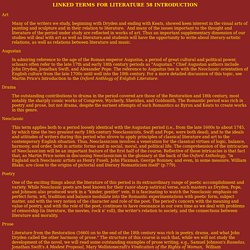
And many of the issues important to the thought and literature of the period under study are reflected in works of art. Thus an important supplementary dimension of our studies will deal with art as well as literature,and students will have the opportunity to write about literary-artistic relations, as well as relations between literature and music. Augustan In admiring reference to the age of the Roman emperor Augustus, a period of great cultural and political power, schoars often refer to the late 17th and early 18th century periods as "Augustan.
" Drama. Neoclassical Literature: Definition, Characteristics & Movement. Neoclassical literature was written between 1660 and 1798.
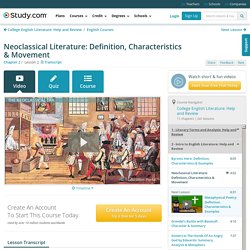
It was a time of both formality and artificiality. In this lesson, we will examine the characteristics and literature of this time period. Explore our library of over 10,000 lessons Click "next lesson" whenever you finish a lesson and quiz. Got It You now have full access to our lessons and courses. You're 25% of the way through this course! The first step is always the hardest! Way to go! Congratulations on earning a badge for watching 10 videos but you've only scratched the surface. You've just watched 20 videos and earned a badge for your accomplishment! You've just earned a badge for watching 50 different lessons. You just watched your 100th video lesson. Congratulations! Congratulations! You are a superstar! Incredible. You have earned a badge for watching 20 minutes of lessons. You have earned a badge for watching 50 minutes of lessons. You have earned a badge for watching 100 minutes of lessons.
What are the main features of poetry in the neo classical age? - Homework Help. The main features of poetry in the neoclassical age were: a) Neoclassical poetry sprung from intellect, not from writers’ whims and imaginations. b) It was a more moralising, educational type of poetry as opposed to the romantic poetry of the Renaissance Period (14th to 17th century).
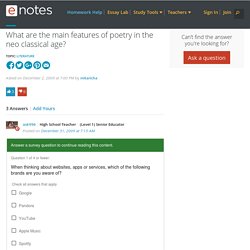
Issues and Articles - John Locke A Philosophical Founder of America. John Locke – A Philosophical Founder of America John Locke (1632-1704) is one of the most important, but largely unknown names in American history today.
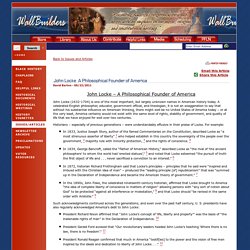
A celebrated English philosopher, educator, government official, and theologian, it is not an exaggeration to say that without his substantial influence on American thinking, there might well be no United States of America today – or at the very least, America certainly would not exist with the same level of rights, stability of government, and quality of life that we have enjoyed for well over two centuries. Introduction to Neoclassisism. The 18th century: Neoclassicism – The Augustan Age – The Transition/ Pre-romantic Age. The 18th century is known as The Age of Enlightenment or The Age of reason, to stress the rational trend of the period and the attitude according to which reason and judgement should be the guiding principles for human activities .
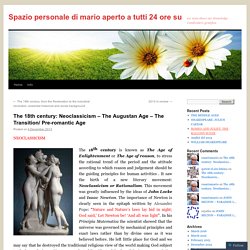
It saw the birth of a new literary movement: Neoclassicism or Rationalism. This movement was greatly influenced by the ideas of John Locke and Isaac Newton. The importance of Newton is clearly seen in the epitaph written by Alexander Pope: “Nature and Nature’s laws lay hid in night; God said,’ Let Newton be! ‘And all was light”. In his Principia Matematica the scientist showed that the universe was governed by mechanical principles and exact laws rather than by divine ones as it was believed before. Art 101: What is Neoclassicism? Next post in the “Art 101” series: Neo-Classicism.
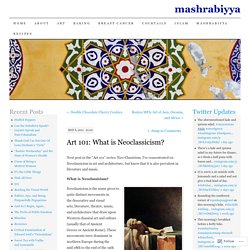
I’ve concentrated on Neoclassicism in art and architecture, but know that it is also prevalent in literature and music. What is Neoclassicism? Death of Marat - Jacques-Louis David, 1793 Neoclassicism is the name given to quite distinct movements in the decorative and visual arts, literature, theatre, music, and architecture that draw upon Western classical art and culture (usually that of Ancient Greece or Ancient Rome). These movements were dominant in northern Europe during the mid-18th to the end of the 19th century. Neoclassicism, in a cultural, artistic, and architectural sense, grew as a response against Rococo, which was seen as over-the-top and shallow. The Enlightenment’s emphasis on rationality in part fueled the classical focus.
Johann Joachim Winckelmann - Raphael Mengs, after 1755. Neoclassical Literature: Definition, Characteristics & Movement. Neoclassical Literature: Definition, Characteristics & Movement.